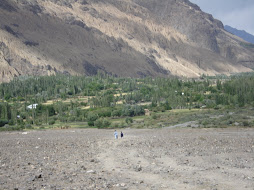By Maqsoodul Mulk (Hindukush Trails)
Militancy and calamity in Pakistan have hampered economic development. It has shaken the confidence of businessmen and travelers to visit and invest in this region. Tourism plays a major role in the livelihood of the Kalash and Chitrali community with a diverse segment of the population directly or indirectly benefiting from it. Stakeholders in tourism are from a vast segment of the population.
They are villagers involved in handicrafts, music and culture, fruit and farm products, shops, hotels, restaurants, transport etc. With robust economic activity, local products find market outlets, each segment of the population gets an opportunity for income generation. A better image does not only attract holiday makers but also investors and businessmen, it brings in opportunities for infrastructure development , better education and health care facilities.
Under present circumstance, this source of income generation and livelihood prospect of the village of Bumboret, Birir, Rumbur and Chitral at large is badly affected. It is very important to send out a message to the world that there is peace and interfaith harmony in the valley of Chitral.
With only negative news going out, it is not easy to promote Pakistan. To highlight our diverse culture, tolerance and hospitality, the Hindukush Trails took on the task to project “A peaceful Chitral.” A plan was initiated to take a delegation from Chitral and the Kalash community to Europe where we managed to get slots in the Baltic States to participate at various concerts in Tallin, Riga and Helenski. With workshops and presentations at various forums and the press and TV covering our activities, the true image of Chitral was introduced to the world. At the home front, the Khyber Pakhtunkhwa government and organizations working in Chitral were approached for help. None was, however, willing to take it on wanting more time to decide. With no organization in Pakistan willing to sponsor the activity, we were left to highlight Chitral on our own. Friends from abroad were approached to extent hospitality and logistics taken on.
Passports, visas (these days no one wants to give a visa to a Pakistani and here was a group venturing out), insurance, air tickets, hotels, food etc., it was quite a task but finally all arranged for a group of eight participants. The concerts where we participated were very well attended. Various countries from the Orient were trying to outdo each other. India had their vocal art and classical singers, the Shaman Rambo of Apatani tribe from Arunachal Pradesh followed by Himalayan folk songs of Ladakh.
Celebrating Sufi music playing multi-instruments was Fakhraddin Gafarov from Azerbaijan, following him were the whirling dervishes of Turkey and Syria, Nepal with its Buddhist rituals and Tibet and Bhutan with its colourful dragon mask dances, each country performed brilliantly. The audience were spellbound and respectfully silent till the Chitrali and Kalash came on the stage with Mirza Ali Jan singing “Mayon i Mo Chulay ki”. On our second song the crowd caught the rhythm.
Then it was a roar of approval on every song, the silent crowd now swayed couldn’t help and finally joined into the delight of government officials and dignitaries. Alongside the performances, there were special workshops and exhibitions exploring many of the rich traditions and cultures of the Orient countries. Live coverage on television and press releases followed simultaneously.The Baltic States get around (four hundred thousand tourists a year) and this was the peak season. A group size of a hundred tourists was considered normal. Hundreds of tourists were at different historical sites being briefed by their guides.
Whenever we passed by the Kalash attired in their lovely dresses and the Chitrali proudly walking in his graceful Pakhol carrying his sitar, heads would turn, conversation stopped and tourist attention diverted from the medieval sites.
The interest of the tourist was genuine and hard to miss. We were asked for photographs and questioned ‘where are you from? We would like to visit your country. “On being told it was Pakistan the remark would be “Ah Osama’s hometown! but we still would want to see it.”
The power of publicity is immense and more so with regard to tourism. What is lacking is projecting the positive in our country and this needs to be understood and taken on by both the government and the development sector. Keeping the potential of tourism in Pakistan merely a PTDC slogan is living in a dream. In reality, we have nothing till we show it to the world… and if we keep it hidden we have lost it. (June 8, 2011)
Send comments to: chitraltoday@gmail.com
Tuesday, June 14, 2011
Subscribe to:
Post Comments (Atom)
Awesome and rugged

Beauty of Chitral

Kishmanja, a beautiful village in Yarkhun valley
Lush green

DIZG: threatened by floods

The legendary village of Ayun in Chitral

On way to Bumburet
Dizg, Yarkhun

About Me

- Zar Alam Khan Razakhel
- Village Dizg, Yarkhun valley, Chitral, Pakistan
- I blog at http://chitraltoday.net (ChitralToday) about Chitral, its people, culture, traditions and issues. I have been writing about Chitral since 2000. Chitral is a scenic valley in the extreme north-west of Pakistan.
No comments:
Post a Comment